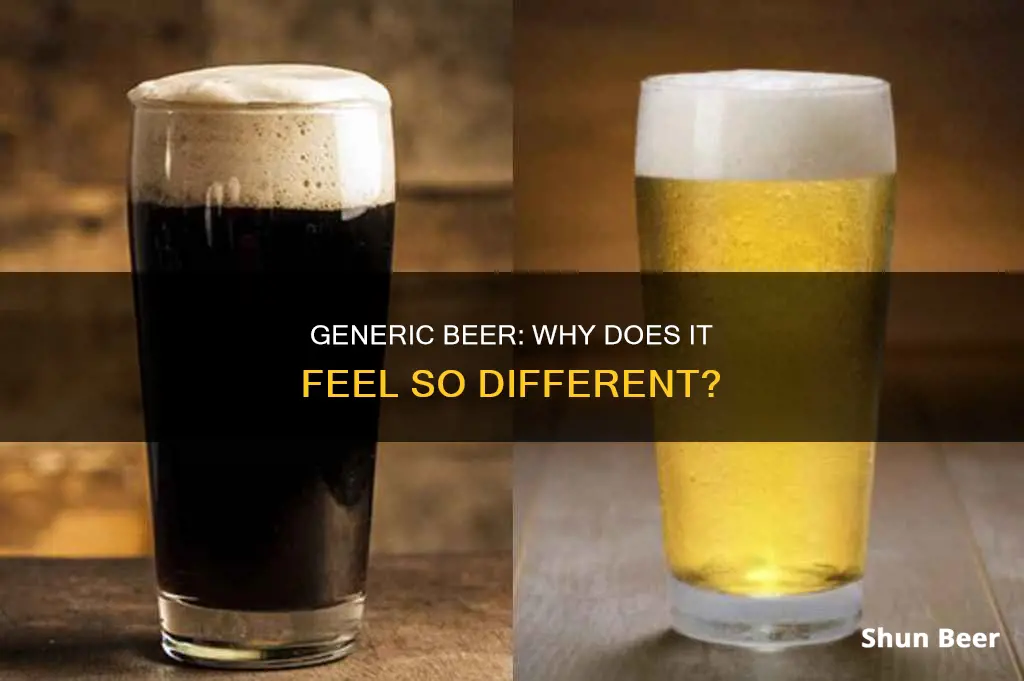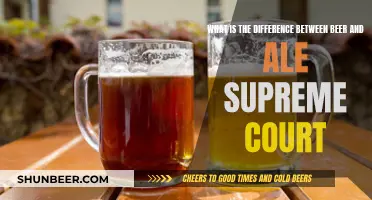
The differences between generic beer and stouts or IPAs are largely due to variations in the brewing process and ingredients used. Stouts and IPAs are both types of ale, which are typically warm fermented using yeast that ferments at higher temperatures, resulting in a stronger and sweeter flavour profile. Lagers, on the other hand, are cold fermented at lower temperatures, yielding a crisper and cleaner taste. Stouts, known for their dark colour and rich flavours, often resemble coffee or chocolate in taste, while IPAs tend to be lighter in colour and have fruity, citrusy, or floral notes.
| Characteristics | Values |
|---|---|
| Colour | Stouts are usually dark, black or coffee-coloured. IPAs are lighter, amber or caramel-coloured. |
| Flavour | Stouts have flavours of coffee, chocolate, liquorice, hazelnut, caramel, dried fruits, and cream. IPAs have flavours of fruit, citrus, pine, wood, herbs, and flowers. |
| Texture | Stouts are creamy, silky, and full-bodied. IPAs are watery, bitter, and less creamy. |
| Alcohol content | Stouts have a high alcohol content. IPAs also tend to have a high alcohol content, but less so than stouts. |
| History | Stouts have been around since the mid-17th century. IPAs were developed in the 18th century. |
| Ingredients | Stouts are malt-oriented and use roasted barley. IPAs are hop-centric and use a lot of hops. |

Yeast and fermentation methods
The type of yeast and fermentation method used in the brewing process play a significant role in differentiating generic beers from stouts and IPAs.
Yeast:
The type of yeast used in brewing is a fundamental differentiator between beer types. Beers can be broadly classified into two categories: ales and lagers. The distinction between these two categories lies in the strain of yeast used for fermentation.
- Ales are produced using the yeast strain Saccharomyces cerevisiae, which thrives at warmer temperatures of around 60°F to 70°F (15°C to 22°C). During fermentation, this yeast rises to the top of the liquid.
- Lagers, on the other hand, are brewed with the yeast strain Saccharomyces pastorianus, which operates at cooler temperatures, typically between 44°F and 55°F (7°C to 13°C). This yeast settles at the bottom of the liquid during fermentation.
Fermentation Methods:
The fermentation process also varies between ales and lagers:
- Top Fermentation (Ales): In top fermentation, the yeast accumulates and floats atop the liquid in the fermentation tank. This method tends to be faster, usually taking a week or more. It requires higher temperatures, ranging from 60°F to 75°F. Ales produced through top fermentation are often described as "complex" or "full-flavored." IPAs and stouts are commonly produced through top fermentation.
- Bottom Fermentation (Lagers): Bottom fermentation involves the yeast slowly settling down at the bottom of the tank. This process takes significantly longer, often exceeding a month. It is conducted at lower temperatures, typically between 42°F and 54°F. Bottom-fermented lagers are known for their crisp, clean, and smooth taste.
People's Perceptions of Popular Beer Brands
You may want to see also

Flavour profiles
Stouts and IPAs have very distinct flavour profiles. Stouts are typically dark beers with a high alcohol content. They are called stouts because they are strong. Common flavours associated with stouts are coffee, chocolate, liquorice, and even hints of hazelnut. These decadent, dessert-like tastes lend themselves well to the consistency of the stout beer. Most stouts have a more creamy, silky, and full-bodied texture.
On the other hand, IPAs have fruity, citrusy, and floral tasting notes, sometimes with a touch of pine. If stouts are the dessert course, IPAs are the palate-cleansing appetisers. They also have a more bitter and watery texture than stouts.
The difference in flavour profiles is due to the types of hops and malts used in the brewing process. Stouts rely on rich, roasted barley malt to create their flavours and have very few hops in comparison to IPAs. IPAs, on the other hand, are almost overloaded with hops, giving them a bitter, edgy flavour.
While stouts are always dark, black IPAs have a similar dark appearance due to the use of roasted malts. However, their hoppy flavour is more consistent with that of a typical IPA. Black IPAs are also known as Cascadian Dark Ales, originating from the Cascadia region of North West USA and Canada.
Different varieties of stouts and IPAs also contribute to their distinct flavour profiles. For example, Imperial Stouts and Imperial IPAs (also known as Double or Triple IPAs) have higher alcohol content than their standard counterparts. Pastry stouts are stouts with sugary or sweet ingredients added, such as liquified cookies or cakes.
White vs Wheat Beer: Understanding the Key Differences
You may want to see also

Signature ingredients
All beer has only four main ingredients: water, malt, hops, and yeast. However, the signature ingredient of stouts is roasted barley malt, which give them their rich, dark colour and sweet, malty flavour. Stouts also have very few hops compared to IPAs. In contrast, IPAs are overloaded with hops, which give them their bitter, edgy flavour. American hops lend fruity, citrusy, big flavours and aromas to IPAs, while English hops produce an earthy, herbal, and often floral taste and aroma.
Hops
Hops are a cone-shaped flower related to cannabis. They are added to beer to lend bitter, citrusy, floral, herbal, and/or piney notes to the final product.
Malt
Malted grain is grain that has started to sprout. It is used in the fermentation process, during which the sugars in the malted grain are converted into alcohol.
Yeast
Yeast is used for fermentation, which is how the sugars in the malted grain get converted into alcohol.
Explore Beer's Diverse World: Styles and Classifications Unveiled
You may want to see also

Colour
Stouts, with their deep hues, evoke a sense of richness and intensity. The dark brown to black colour of stouts, such as the well-known Guinness, is achieved through the use of roasted barley in the grain mix. This imparts a unique flavour and makes stouts stand out visually.
On the other hand, IPAs (India Pale Ales) tend to be amber-coloured ales, deriving their lighter shade from the use of lighter malts. However, it's important to note that not all IPAs adhere strictly to this colour scheme. Black IPAs, for instance, defy expectations by adopting the dark appearance of stouts while retaining the hoppy flavour characteristic of IPAs.
The colour of beer is not just an aesthetic choice but also influences the overall drinking experience. The darker colours of stouts can give the impression that they might be challenging to drink, while the lighter shades of IPAs suggest a more refreshing and approachable beverage.
Additionally, the colour of beer can provide subtle hints about its flavour profile. For example, the darker hues of stouts suggest flavours like coffee, chocolate, and toffee, while the lighter colours of IPAs hint at fruity, citrusy, or floral notes.
St. Bernardus Beers: Understanding Their Unique Differences
You may want to see also

Origins
The differences between generic beer, stouts, and IPAs can be traced back to their origins.
Stouts and IPAs originated in 18th-century England, although stouts date back to the mid-17th century. Stouts were originally a stronger version of porter beers, which were very popular in London taverns in the 1700s. The word "stout" in old English described something strong, so these robust porters became known as "stout porters". Irish brewers later adopted this style of beer, dropping the "porter" name, and the beers became simply known as stouts.
IPAs, or India Pale Ales, were also developed in the 18th century as an export beer for the British living in India. Regular pale ales wouldn't survive the journey, so brewers created a heavier, hopped version that could withstand the voyage. The addition of hops and higher alcohol content preserved the beer, creating a stronger version of a pale ale with a pronounced hoppy flavour.
The two beer styles have different colour profiles, with stouts being darker, like coffee, and IPAs having a lighter caramel or amber hue. However, the colour difference isn't always clear-cut, as some IPAs, known as Black IPAs, also have a dark appearance due to the use of roasted malts.
Flavour Profiles
The flavour profiles of stouts and IPAs also differ significantly. Stouts typically have flavours of coffee, chocolate, licorice, and even hints of hazelnut, giving them a dessert-like taste. They tend to have a creamy, silky, and full-bodied texture. On the other hand, IPAs offer fruity, citrusy, and floral notes, sometimes with a touch of pine, creating a bitter and watery texture. If stouts are the dessert, IPAs are the palate-cleansing appetiser.
Signature Ingredients
Despite both being ales, stouts and IPAs differ in their key ingredients. Stouts rely on rich, roasted barley malt to create their flavours and typically have very few hops. In contrast, IPAs are overloaded with hops, giving them their bitter, edgy flavour. American hops lend fruity, citrusy, big flavours, while English hops result in an earthy, herbal, and floral aroma and taste.
Bicycles and Beers: A Tale of Two Wheels and Ales
You may want to see also
Frequently asked questions
Generic beers, which are usually lagers, are lighter, crisp, and clean in taste. They are typically "cold fermented" at lower temperatures and have a lower alcohol content. On the other hand, stouts and IPAs are types of ales, which are "warm fermented" at higher temperatures, resulting in a stronger and sweeter flavour profile. Stouts are known for their dark colour and flavours of coffee, chocolate, caramel, and even hints of hazelnut. They have a creamy, silky, and full-bodied texture. In contrast, IPAs are characterised by their fruity, citrusy, and floral notes, often with a touch of pine. They have a more bitter taste and a watery texture compared to stouts.
Stouts and IPAs have distinct flavour profiles. Stouts are known for their dark colour and flavours of coffee, chocolate, caramel, and even hints of hazelnut. They have a creamy, silky, and full-bodied texture. In contrast, IPAs are characterised by their fruity, citrusy, and floral notes, often with a touch of pine. They have a more bitter taste and a watery texture compared to stouts.
Despite their differences, stouts and IPAs do share some similarities. Both fall under the category of ale and originated in 18th-century England. They are also brewed with the same four basic ingredients: water, malt, hops, and yeast.







